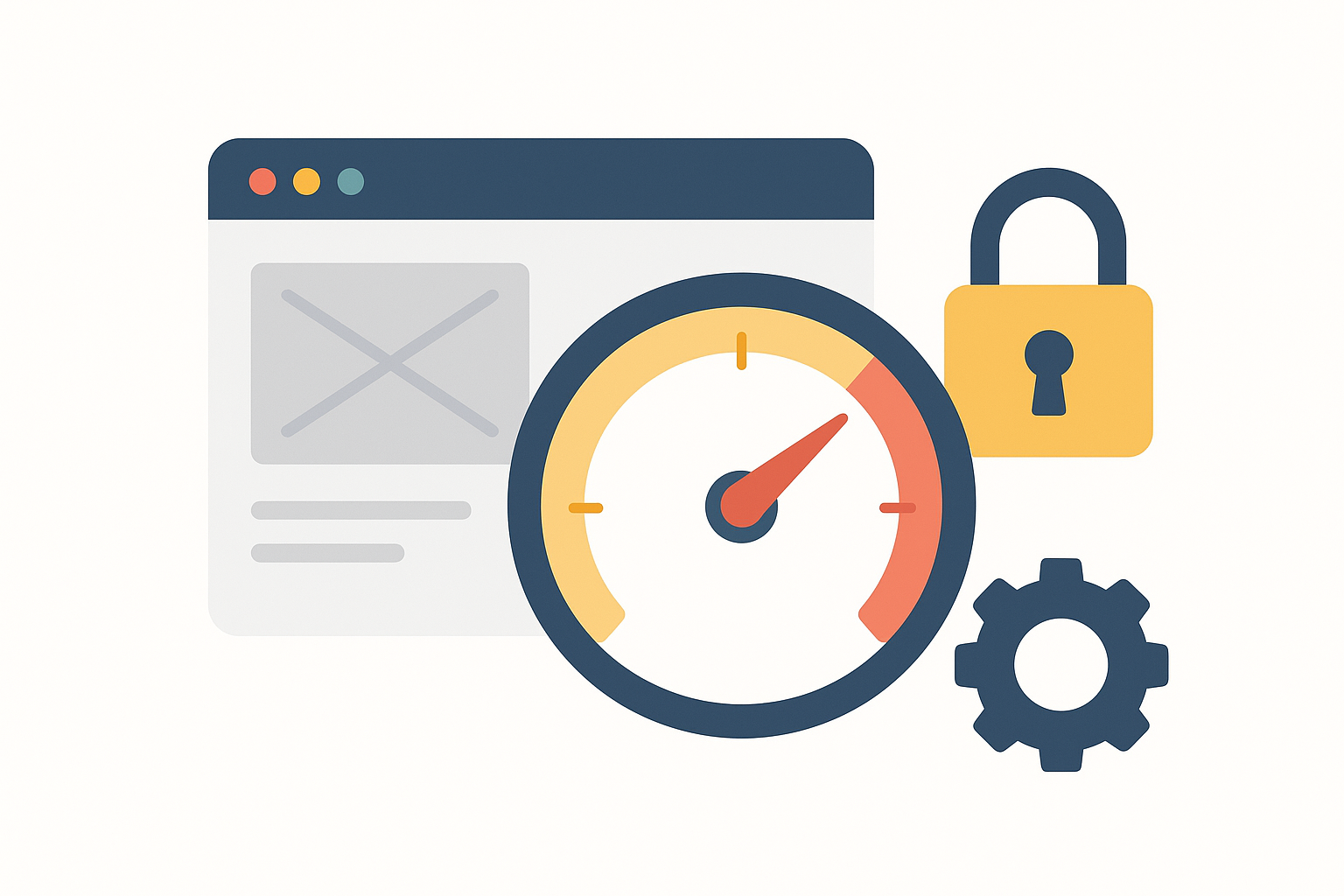This post is written specifically for your website FixHackedSite, focusing on speed performance, robust security, and modern best practices. It includes bold, italic, and underlined formatting for readability and emphasis.
Introduction
In an age where users expect a website to load in under 3 seconds, and cyberattacks are increasing at an alarming rate, optimizing your website for both speed and security is no longer optional — it’s critical.
At FixHackedSite, we specialize in helping website owners create fast, secure, and resilient web environments that are trusted by users and loved by search engines.
In this guide, we’ll walk you through actionable strategies, tools, and expert tips to make your site blazing fast and rock-solid secure.
Why Website Speed and Security Matter
Your website is your digital storefront. If it loads slowly or isn’t secure, you risk:
- Losing customers
- Getting penalized by search engines
- Becoming a victim of cyberattacks
 Damaging your brand’s reputation
Damaging your brand’s reputation
1. Website Speed Affects:
- 🕒 User experience – 53% of users leave if a mobile site takes more than 3 seconds to load.
- 📉 SEO rankings – Google uses page speed as a direct ranking factor.
- 💰 Conversions – A 1-second delay in page load time can reduce conversions by 7%.
2. Website Security Affects:
- 🔐 User trust – Visitors are wary of websites without HTTPS or visible protection.
- 🚫 Data safety – Hacks can expose user data, causing legal and financial damage.
- 🔎 Search visibility – Google flags unsafe websites and may de-rank them.
Core Principles of Website Speed Optimization
Website speed optimization means minimizing the time it takes for your web pages to load completely. There are several factors at play:
- Server response time (TTFB)
- Frontend resource loading (images, CSS, JS)
- Client-side rendering
- Third-party scripts
To optimize speed, you must reduce, compress, defer, and cache wherever possible.
Tools to Measure Website Speed
Before optimizing, measure your current performance using these tools:
- Google PageSpeed Insights – Offers detailed improvement suggestions.
- GTmetrix – Gives waterfall charts and in-depth loading analysis.
- Pingdom Tools – Great for simple speed checks.
- Lighthouse (Chrome DevTools) – For technical audits, including SEO and performance.
🎯 Aim for a score of 90+ on mobile and desktop.
Common Speed Bottlenecks
Let’s look at what’s slowing your site down:
- Uncompressed images
- Unminified CSS/JS files
- Too many HTTP requests
- Render-blocking scripts
- Lack of browser caching
- Slow or shared hosting
- Unoptimized WordPress themes/plugins
Speed Optimization Techniques
Now, let’s fix those issues step-by-step.
1. Use a Lightweight Theme: Avoid bloated themes filled with unnecessary features.
2. Optimize Images:
- Compress images using TinyPNG or ImageOptim.
- Use next-gen formats like WebP.
 3. Minify CSS, JS, and HTML: Minification removes unnecessary spaces and comments.Use plugins like Autoptimize, Fast Velocity Minify, or manually minify with Gulp/Webpack.
3. Minify CSS, JS, and HTML: Minification removes unnecessary spaces and comments.Use plugins like Autoptimize, Fast Velocity Minify, or manually minify with Gulp/Webpack.
4. Lazy Load Media: Only load images/videos when they appear on screen.
Most modern browsers support loading=”lazy”.
5. Use a Content Delivery Network (CDN): Distribute content globally for faster access.Top CDNs: Cloudflare, BunnyCDN, KeyCDN
6. Enable Caching:
Use both:
- Browser Caching – Stores files locally for return visitors.
- Page Caching – Delivers static HTML instead of regenerating pages.
🧰 Plugins: WP Rocket, W3 Total Cache, LiteSpeed Cache
7. Reduce HTTP Requests: Merge CSS/JS files and avoid too many fonts or external scripts.
8. Choose a Fast Hosting Provider:
Avoid cheap shared hosting. Opt for:
- VPS (e.g. DigitalOcean, Linode)
- Managed WordPress hosting (e.g. Kinsta, Cloudways)
What is Website Security?
Website security means protecting your site from:
- Malware injections
- Brute-force login attempts
- SQL injections
- XSS attacks
- DDoS attacks
- Data leaks
A secure site has firewalls, SSL, user access control, daily backups, and constant monitoring in place.
Common Website Vulnerabilities
✅ Weak passwords
✅ Outdated plugins/themes
✅ No HTTPS
✅ Public admin URLs (/wp-admin)
✅ Insecure file permissions
✅ Lack of security headers
Essential Security Optimization Practices
Follow these to lock down your website:
1. Install an SSL Certificate: Mandatory for HTTPS. It encrypts data between browser and server.
Let’s Encrypt offers free SSL certificates.
2. Keep Everything Updated:
Always use the latest versions of:
- WordPress core
- Themes
- Plugins
Hackers often target known vulnerabilities in outdated software.
3. Use Strong Passwords + 2FA: Avoid “admin” or “123456.” Use password generators and enable two-factor authentication.
4. Hide Login URLs: Use plugins like WPS Hide Login to change /wp-admin or /login.
5. Set File Permissions: Your wp-config.php file should never be writable (set it to 400 or 440).
6. Disable Directory Listing: Prevent hackers from browsing your folders. Add this to .htaccess:Options -Indexes.
7. Install a Security Plugin:
Recommended:
- Wordfence
- Sucuri
- iThemes Security
These provide firewalls, malware scanning, and login protection.
How to Prevent Website Hacks
 Here’s a checklist to prevent most common hacks:
Here’s a checklist to prevent most common hacks:
Area Recommendation
Hosting: Use managed hosting with firewalls
Backups: Set automatic daily backups (e.g., UpdraftPlus)
Malware: Run weekly scans
Admin Access: Limit logins to specific IPs
SQL Injection: Sanitize user inputs in forms
Plugins: Remove unused or outdated ones
Monitoring: Enable uptime & file change monitoring
🛡️ A proactive approach always beats a reactive cleanup.
CDNs and WAFs Explained
What is a CDN?
A Content Delivery Network stores cached versions of your site on servers worldwide. It:
- Improves loading speed
- Handles traffic spikes
- Blocks bad bots
Popular CDNs:
- Cloudflare (free & premium)
- BunnyCDN
- StackPath
What is a WAF?
A Web Application Firewall monitors and filters traffic to block malicious requests.
Cloudflare’s WAF, Sucuri Firewall, and Astra Security are great tools.
WordPress-Specific Tips
If you’re using WordPress, here are extra tips:
🔌 Limit plugins: Use only essential, well-reviewed plugins.
🧹 Clean up the database: Use WP-Optimize or Advanced Database Cleaner.
🔁 Limit login attempts: Prevent brute-force attacks.
📬 Disable XML-RPC if not used (often a vector for DDoS).
FixHackedSite Services Overview
At FixHackedSite, we offer:
✅ Speed Optimization Services
- Image compression
- CSS/JS minification
- CDN setup
- Lazy loading
- Hosting configuration
✅ Security Hardening Packages
- Full malware cleanup
- Firewall & WAF installation
- SSL integration
- Login protection
- Real-time monitoring setup
✅ Ongoing Maintenance
- Weekly backups
- Uptime monitoring
- Plugin/theme updates
- Manual security checks
Our goal? Keep your site fast, safe, and hacker-free — 24/7.
Final Thoughts
Your website’s performance and protection directly impact its success, trustworthiness, and profitability. Whether you’re running a business, a blog, or an e-commerce store, investing in speed and security optimization is one of the smartest decisions you can make.
If your site is slow, vulnerable, or already hacked, don’t wait.
📞 Contact FixHackedSite today and let our expert team turn your website into a fast, secure, and professional platform your users — and Google — will love.



